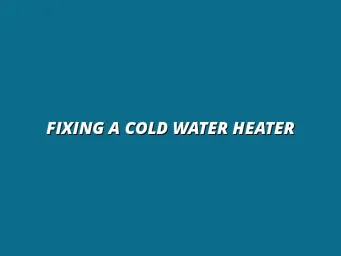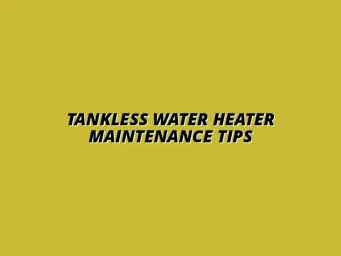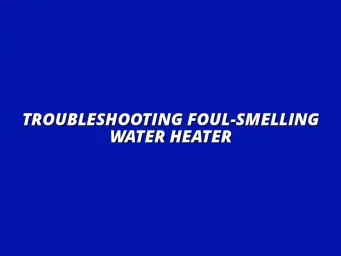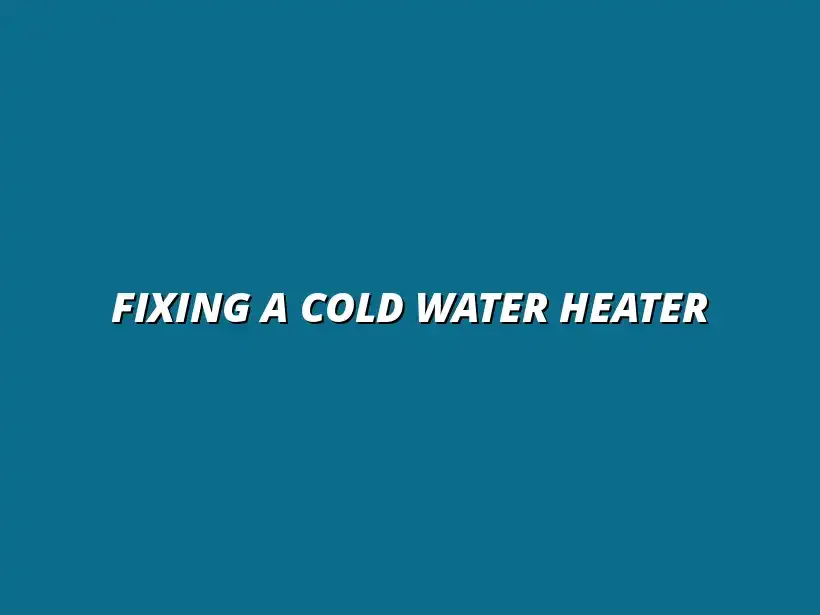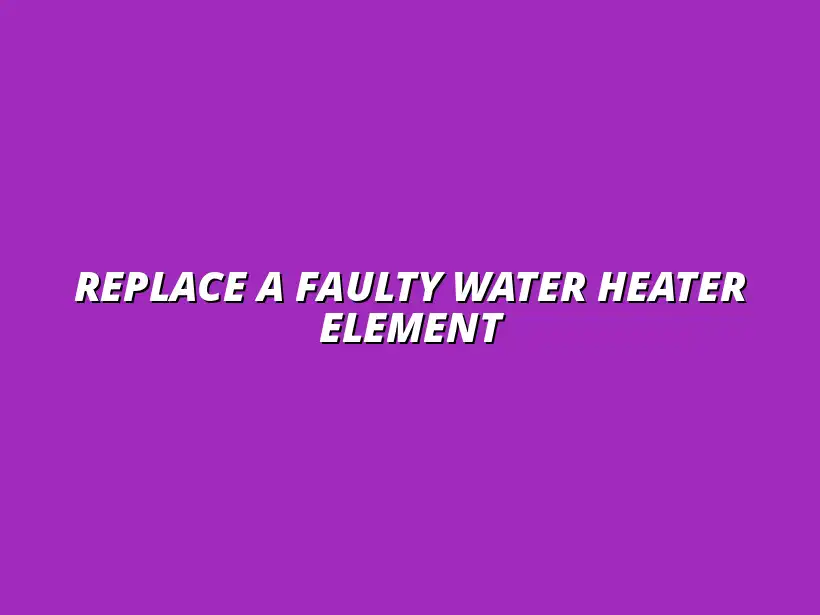
Replace a Faulty Water Heater Element
Understanding Water Heaters and Their Components
Water heaters are essential appliances found in most homes, providing us with hot water for showers, laundry, and dishwashing. Understanding how they work and knowing their components can help in maintaining them effectively. A water heater typically consists of several key parts, including the tank, thermostat, heating elements, and various valves. For instance, learning how to fix a leaky faucet can prevent wasted water and energy.
The heating elements are particularly crucial as they are responsible for heating the water inside the tank. There are usually two elements in larger units — the upper and lower elements. These components work together to ensure that your water heater operates smoothly and efficiently.
The Role of Water Heater Elements in Functionality
The heating elements in a water heater are like the heart of the system. They convert electrical energy into heat, which then warms the water stored in the tank. If one of these elements fails or is not functioning properly, it can lead to inadequate hot water supply.
Each element has a thermostat to control the temperature of the water. This ensures that the water stays at a safe level, preventing overheating. Understanding how these elements function can help homeowners troubleshoot problems when they arise. If you're facing issues with your water heater not starting, you might find helpful advice on fixing a water heater that won't start.
- Upper Element: Heats the water at the top of the tank.
- Lower Element: Heats the water at the bottom, ensuring even heating throughout.
- Thermostat: Monitors and regulates water temperature.
Types of Water Heaters and Their Element Differences
There are primarily two types of water heaters: tank and tankless. Each type has different configurations and functions, particularly in terms of heating elements. A traditional tank water heater stores a large amount of water, while a tankless model heats water on demand.
In a tank water heater, you will generally find two heating elements, whereas tankless units utilize powerful heating coils that activate when hot water is needed. This results in differences in energy efficiency and heating speed. Regular water heater maintenance is crucial for both types.
- Tank Water Heaters: Usually have two elements.
- Tankless Water Heaters: Use heating coils and provide hot water instantly.
- Heat Pump Water Heaters: Use electricity to transfer heat instead of generating it.
Recognizing Signs of a Faulty Water Heater Element
Over time, heating elements can wear out or become inefficient, leading to various problems with your water heater. Recognizing early signs of a faulty element can save you from more extensive repairs. It's essential to pay attention to how your water heater operates to catch issues early. Regularly flushing your water heater can help prevent sediment buildup and extend the life of your elements.
Some common symptoms include inconsistent water temperature and unusual noises coming from the heater. Ignoring these signs can lead to total failure, which is inconvenient and often costly.
Common Symptoms Indicating a Bad Element
When you notice problems with your water heater, it’s essential to identify whether the heating elements are the culprits. Here are some common symptoms to watch for:
- Inconsistent Water Temperature: Fluctuating temperatures can indicate a failing element.
- Unusual Noises: Sounds like popping or rumbling can signal sediment build-up or failing elements.
- Increased Energy Bills: A malfunctioning element may cause the system to work harder, resulting in higher bills.
Inconsistent Water Temperature
Inconsistent water temperature is often the first sign of trouble. If you find that your hot water is suddenly lukewarm or cold, it could be due to a malfunctioning heating element. This instability can lead to a frustrating experience when trying to take a shower or wash dishes.
It's best to address this issue as soon as possible to prevent further damage. A faulty element not only affects comfort but can also cause the heater to consume more energy, which will reflect on your utility bills. If you need professional help, consider contacting a plumber in your area.
Unusual Noises from the Heater
Another noticeable sign of a faulty water heater element is unusual noises. If you hear loud popping or rumbling sounds, it could mean there's sediment buildup around the heating element. As the element tries to heat the water, it struggles against the buildup, causing these disruptive noises.
Paying attention to these sounds can help you prevent additional wear and tear on your water heater. Timely intervention can not only extend the life of your appliance but also improve its efficiency. Similarly, understanding how to install a French drain can help with water management around your home.
Step-by-Step Guide to Replace a Faulty Water Heater Element
Replacing a faulty water heater element might seem intimidating, but with the right guidance, it can be a straightforward process! By following a clear, systematic approach, you can ensure the job is done efficiently and safely. Here’s how to tackle this task step-by-step!
Draining the Water Heater
Before you can swap out the faulty element, you need to drain the water heater. This step is crucial to avoid any water spills or accidents while you’re working. Let’s look at some effective methods for draining your water heater.
- Turn off the power supply to the water heater to prevent any electrical issues.
- Connect a garden hose to the drain valve located at the bottom of the tank.
- Open the drain valve and let the water flow out into a bucket or appropriate drainage area.
- Open a hot water tap in your home to help the water drain more efficiently.
Methods for Efficient Draining
Besides basic draining, there are a few tips you can use to make this process smoother. Following these methods ensures that you’ll get the most water out of the tank before you start the replacement. Proper drainage is essential, just like knowing how to install a kitchen faucet correctly.
- Flush the tank with cold water after draining to remove sediment buildup.
- Use a wet/dry vacuum to suck out any remaining water in the tank for a thorough job.
With the tank drained, you can move on to safely disconnecting the water lines.
Safely Disconnecting Water Lines
Before removing the faulty element, ensure that all water lines are properly disconnected. This process prevents leaks and makes the replacement safer. Here’s how to do it correctly:
- Shut off the cold water supply valve to the heater.
- Use adjustable wrenches to gently loosen the fittings on the inlet and outlet pipes.
- Carefully remove the pipes and set them aside, ensuring they don’t get damaged.
Removing the Faulty Element
Now it’s time to remove the faulty element. This step requires careful handling as you’ll be working with electrical components. Let’s discuss the tools and techniques you need for successful removal.
Tools and Techniques for Element Removal
Having the right tools is essential for removing the faulty water heater element without damaging anything. Here’s a list of the tools you’ll need:
- Socket wrench or element wrench for loosening the element.
- Bucket or towel to catch any water that may spill.
- Gloves for hand protection.
To remove the element, simply follow these steps: loosen the element nuts with the wrench, lift out the old element, and place it in the bucket.
Common Challenges During Removal
While removing the element, you might encounter a few challenges. Here’s what you should watch out for:
- Stubborn elements that may be corroded or stuck due to mineral buildup.
- Water still remaining in the tank, which can cause spills if not drained properly.
- Electrical connectors that are difficult to detach.
Overcoming these challenges will ensure a smooth installation of the new element!
Installing the New Water Heater Element
Once the old element is out, it’s time to install the new one! This is a crucial step that can affect the efficiency of your water heater. Here’s how to do it correctly.
Ensuring Proper Fit and Sealing
When installing the new element, it’s essential to ensure it fits properly and seals well. Here are some tips:
- Check the specifications of the new element to match it with the old one.
- Apply a little plumber's tape on the threads of the new element for a better seal.
- Carefully screw the new element into place, ensuring it is tight but not overly so to avoid damage.
Reconnecting Electrical Connections Safely
After securing the new element, the next step is to reconnect the electrical connections. Always prioritize safety during this phase:
- Double-check that the power is off before handling any wires.
- Follow the manufacturer’s wiring diagram to connect the wires correctly.
- Use wire nuts to secure the connections and ensure they are insulated.
Post-Replacement Steps and Maintenance Advice
Once the installation is complete, it’s essential to follow some post-replacement steps to ensure everything operates smoothly. This will help you avoid future issues and maintain your water heater effectively.
Refilling the Water Heater and Restoring Power
Now that your new element is installed, it’s time to refill the water heater. Here’s how to do it:
- Close the drain valve and remove the garden hose.
- Turn on the cold water supply to the tank and allow it to fill.
- Open a hot water tap to allow air to escape while the tank fills.
Checking for Leaks After Installation
After refilling, you should check for leaks around the new element. Look for signs of dripping or wetness. If you notice any, try tightening the connections. If leaks continue, you might need to reapply plumber's tape or recheck the installation.
Monitoring Temperature Settings for Efficiency
Once everything is in place, turn the power back on and monitor the temperature settings. Ensure the water heater is set to a safe temperature, usually around 120°F. This helps maintain efficiency and prevent scalding!
Frequently Asked Questions About Water Heater Elements
After completing your replacement, you might still have questions. Here are a couple of frequently asked questions about water heater elements:
What are the average lifespans of water heater elements?
Water heater elements typically last about 6 to 12 years, depending on usage and water quality. Regular maintenance can extend their lifespan!
Can I replace just one element in a dual-element water heater?
Yes, you can replace just one element in a dual-element water heater. However, it’s often recommended to replace both elements for optimal performance.
Final Thoughts on Water Heater Element Replacement
Replacing a faulty water heater element can seem daunting, but with this guide, you’re well-equipped to tackle the task! By following these steps and taking the time to understand the process, you can ensure your water heater operates efficiently and safely.
When to Seek Professional Help
While many homeowners can handle a replacement, there are times when it’s best to call a professional. Recognizing when you need help is crucial for your safety!
Indicators That Professional Service is Necessary
If you experience consistent leaks, have difficulty with electrical connections, or feel uncertain about any part of the process, it’s wise to seek professional assistance. Better safe than sorry!
Cost Considerations for Professional Replacement
Hiring a professional can range from $100 to $300, depending on your location and the complexity of the job. While it’s a bit of an investment, the peace of mind and quality service are often worth it.
Long-Term Maintenance Tips for Water Heaters
To keep your water heater running smoothly, regular maintenance is key! Here are some tips to help you stay on top of it:
Regular Inspection and Cleaning Recommendations
- Inspect the water heater every few months for signs of leaks or corrosion.
- Flush the tank annually to remove sediment buildup.
- Check temperature settings to ensure efficiency.
Signs Your Water Heater Needs Immediate Attention
Be on the lookout for signs that your water heater might need repairs:
- Rusty or discolored water.
- Unusual noises like popping or rumbling.
- Inconsistent hot water supply.
Staying vigilant can save you time and money in the long run!
